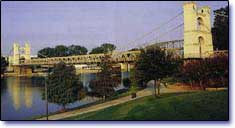

Places in Time
Dam's birth surrounded by hostility
By J.B. Smith, Waco Tribune-Herald
The quickest way to start an argument in Waco in 1926 was to mention damming the Bosque River .
The Waco Chamber of Commerce and the Waco Water Commission declared the city of 50,000 people desperately needed a lake to avoid a water famine.
They called a $3.5 million bond election to build what was then called Lake Bosque . They succeeded, but not without a struggle.
The equally prominent anti-dam crowd, including the mayor, scorned the proposal as a foolhardy luxury. The dam could burst and wash away East Waco , they warned. The water would be polluted and undrinkable, and the project would sink Waco into debt it could not support, the opponents said.
They argued that the city could meet all its water needs by sinking more wells.
"Which do you prefer, Mr. Citizen of Waco ?" asked an ad in the
Waco Times-Herald in September 1926, just before the bond election. A "no" vote would ensure low taxes, pure water and prosperity, the ad assured.
A "yes" vote would create a lake that benefits "crapshooters," "ukelele players" and "speculators," and which is polluted by "cow lots, hog lots, human excreta" and "diseased bathers (venereal)."
The battle raged on through the spring and summer of 1926. A series of community meetings in early September at Waco High School drew up to 800 people to hear sometimes raucous debate. The two sides attacked each other with full-page ads, and someone burglarized the Waco filter plant to rummage through records.
In an era before the U.S. Army Corps of Engineers began damming streams all over Texas , a dam on the Bosque seemed ambitious and risky. To some old-timers in Waco , it also seemed wholly unnecessary.
Many Waco residents could remember the late 19th century, when Waco seemed to have an inexhaustible water supply and was known as " Geyser City " for the artesian wells that spurted water high in the air.
By 1912, municipal wells slackened and no longer met city needs. The Waco Water Commission, an elected body that had taken over the private Waco waterworks, decided to tap into the muddy, salty waters of the Brazos .
The commission built what is now the Riverside Treatment Plant near Cameron Park to filter the water and mix it with groundwater. Many residents, however, said the water was still too salty to drink.
When drought struck in 1925, the city consumed nearly the entire flow of the Brazos . The filter plant was down to the dregs, washing out a hundred tons of mud a day from its filters, according to dam proponents.
The anti-dam crowd said Waco still had plenty of potential groundwater near the Brazos in East Waco , and the lake would be a mere "plaything."
Judge William Sleeper, former water commission chairman, said the city had hosted 45,000 troops at Waco 's Camp MacArthur during World War I and never suffered a water shortage.
"And now it is no uncommon thing for those who don't live in Waco to say it is not a fit place to live in because of poor water, and we have actually invited slander in order to secure a beautiful Lake Bosque at the expense of the water department," he wrote in the Times-Herald.
Meanwhile, dam proponents located former Camp MacArthur officials who revealed that the Army camp had nearly moved away because water supplies were low.
To satisfy those who feared the dam would be unsafe, lake advocates telegraphed Maj. Gen. George W. Goethals, builder of the Panama Canal . He agreed to come to Waco after the bond election and help select a safe dam site.
The night before the election, the Lake Bosque Club, an dam advocate group led by E.W. Provence, W.E. Darden, W. Berry Brazelton, A.M. Goldstein and others, called every telephone number in town.
On Sept. 14, 1926, Waco voters headed to the polls and approved the bonds by a razor-thin margin of 2,562 to 2,384.
The outcome was immediately challenged by William Waldo Cameron, a leading dam opponent and lumber magnate who owned much of the land the lake would ultimately flood. He filed a lawsuit that went all the way to the Texas Supreme Court, which ruled in 1928 that the election was proper.
Meanwhile, the water commission, hoping to appease dam opponents, downsized lake plans so it could be built for $2.5 million.
Goethals gave his blessing to the dam site just upstream from the current Lake Waco dam. However, he warned — accurately — that upstream farms could cause the lake to silt up.
A 60-man crew went to work in the Bosque bottoms, clearing 2,500 acres and cutting 25,000 cords of wood. In 1929, Callahan Construction Co. began working day and night to build the dam, using mules and tractors.
When the dam was completed in May 1930, the Callahan firm ran an ad heralding the lake as "the crowning achievement of Waco 's 80 years of Romantic History. . . . Plentiful, pure water and city growth are inseparable."
A quarter-century later, controversy over the dam had faded. Drought-stricken Waco residents only wished they had built a larger dam. A new Lake Waco was on the way to cover up the silted-up reservoir. And history had again proven that when it comes to public works, no solution is permanent.
For
more information, contact: John Young • Waco
Tribune-Herald •